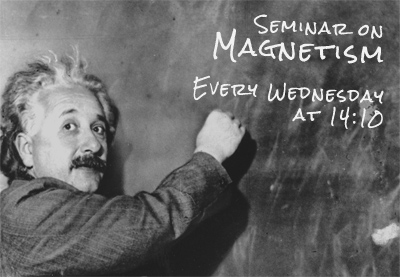Seminar on Magnetism
Group of Magnetism at the Department of Condensed Matter Physics
of Charles University and MGML has a pleasure to invite you to attend the joint seminar
on 29th November 2023 at 14:10
at Faculty of Mathematics and Physics of Charles University, Ke Karlovu 5, 121 16 Praha 2
Lecture room F2
Jakub Zázvorka
Institute of Physics of the Charles University, Ke Karlovu 5, Prague 2, Czech Republic
Skyrmion Diffusion a Lattices in Continuous Thin Films
Jakub Zázvorka » Skyrmion Diffusion a Lattices in Continuous Thin Films
Institute of Physics of the Charles University, Ke Karlovu 5, Prague 2, Czech Republic
Online link: cesnet.zoom.us Ask R. Colman for password.
Location: Lecture room F2, Ke Karlovu 5, Prague
Magnetic skyrmions, whirls of magnetization with topological charge, have attracted major attention as their topology in real space governs intriguing electromagnetic responses. In particular, the dynamics is of key importance for possible use in spintronic applications with novel functionality. However, the non-trivial topology of the skyrmion state gives rise to the skyrmion Hall effect, an analogy to the Magnus effect. The deviation of the motion parallel to the driving electrical current results in a challenge for the skyrmion to be used in applications. Recently, thermally induced skyrmion motion in thin film systems, initially deemed negligible by theory compared to the current induced motion, was observed and reported. The uncovered thermal diffusive skyrmion dynamics showed displacement comparable to current-induced motion and its stochastic nature was applied in devices usable for probabilistic computing. The motion of skyrmions observed in an engineered material stack follows the diffusive motion assuming rigid particles with no correlation. Theory also predicts that the gyrotropic force originating from the finite topology gives rise to a drastic decrease in the diffusion coefficient. While advantageous for deterministic devices, this diffusion suppression is a key obstacle for unconventional devices that are actively making use of stochasticity. Antiferromagnetically coupled materials can be used to tune the topological charge by modifying the individual material layers. The systematic investigation of varying the compensation ratio of magnetic moments in the optimized SyAFM system with analysis accounting for pinning effects allows for disentangling the influence of the topology on the diffusive motion.
At higher skyrmion densities, skyrmion lattices emerge in the material. Deviations from a hexagonal order are observed with the formation of defects which can propagate throughout the system. Observing the dynamics of the lattice and its evolution with time and external parameters, the lattice formation process and the structural phases of the two-dimensional system can be studied.


